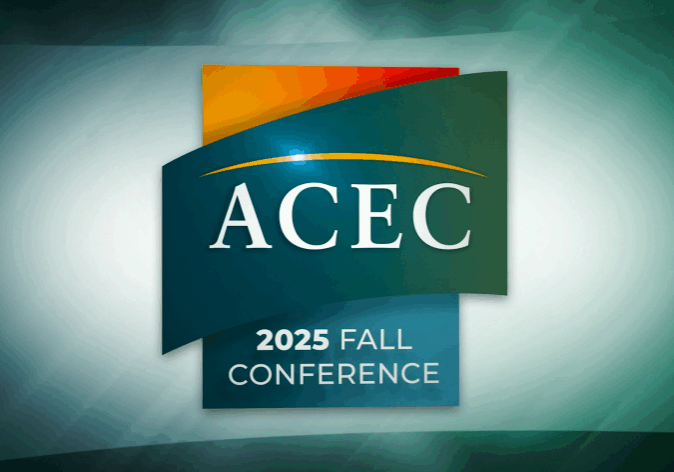
Remarks from ACEC President and CEO Linda Bauer Darr from the opening general session of the 2025 Fall Conference in San Diego, CA. Remarks as presented:
This is a big crowd! I learned yesterday that we have almost 1,200 people here — that’s a record, and it’s really blowing the doors off. Thank you all for being here.
We’re gathering at a time when major challenges are facing both our industry and our nation: a potential government shutdown, new restrictions on H-1B visas, and most recently, a new policy from the U.S. Department of Transportation that could significantly impact engineering firms with DBE certifications — and those who partner with them as well.
We’ve been waist-deep in these issues, and we’re going to have to wade in even further. On Tuesday, we’ll hold a forum — better described as a working conversation — to address these challenges. It’s listed in your conference app and will be recorded and made available to attendees who can’t join in person.
In the near term, ACEC will work closely with DBE firms, our state organizations, and state DOT partners to develop recommendations for the U.S. DOT that help firms with recertification and ease the transition as much as possible. We’ll also continue to provide educational resources and ongoing advocacy support as we move through these challenges together. You may have noticed that this year’s program is heavily tech-centric — and that’s what I want to focus on this morning. Now, as you know, Washington can be unpredictable — maybe you’ve figured that out by now.
The challenges we’re facing are hugely disruptive, and any one of them could take a year’s worth of strategy to address. So this is a kind of triple threat, and I ask you to work with us, to be patient. We’ll do everything we can to help, to communicate, and to move through this together.
Today happens to mark the 15th anniversary of Instagram. Fifteen years ago, Instagram took two months to reach one million users. ChatGPT did it in five days.
In just 15 years, we’ve gone from a platform that lets us post images online to one that can generate them on demand with uncanny accuracy and realism. And AI’s capacity doubles every seven months — meaning that a moment in time is a lifetime in technology.
This morning, I want to talk about what that means for the business of engineering — what we stand to gain if we get this right, and what we stand to lose if we don’t. AI is reshaping project design and delivery.
It’s accelerating the pace of completion and redefining client expectations. For years, we’ve said that engineering is essential. But in a tech-driven world, engineers are even more than that — we are indispensable. We are the essential humanity in an otherwise mechanical series of calculations and formulas.
We must remember: it takes people — it takes us — to lead. Technology can’t do that for us.
Recently, I went down a bit of a rabbit hole with ChatGPT. I asked: “What if engineering firms fail because technology takes over?” The answer was striking. It said: if design engineering firms failed because technology replaced much of their role, it would be because the profession failed to claim its role in guiding, governing, and complementing technology.
Truer words have never been spoken by a machine.
ChatGPT went on to identify four reasons that might lead to that failure:
Failure to adapt to technology — by dismissing AI and automation as a fad instead of proactively adopting and shaping it; by failing to invest in digital literacy, even among leaders; and by clinging to traditional billing models instead of moving toward tech-driven, value-based pricing.
Failure of leadership and vision — by not setting a roadmap for how to integrate technology, by underinvesting in R&D, by letting tech giants dominate design generation, and by focusing too much on short-term profits at the expense of long-term innovation.
Failure in professional positioning — by not defining the human value of engineers, allowing ourselves to be seen as drafters instead of strategic advisors, or by neglecting to advocate for updated licensure laws that require human oversight of AI-generated work.
Failure in client relationships — by not pivoting to higher-value services like risk management, sustainability, resilience, and stakeholder communication, or by ignoring client demand for innovation and remaining stuck in “business as usual.”
So that’s the list of what not to do, according to ChatGPT. From that, it’s clear that engineering is higher-order than technology.
I asked ChatGPT, “How is engineering superior to technology?”
The answer was brilliant: “Technology is the what, and engineering is the why and the how.” Engineering endures. It’s principle-driven, while technology is tool-driven. If AI is a tool, it must be guided. If we don’t adopt, learn, shape, and wield it wisely, it will get away from us — and we risk losing out to competing industries. In the end, we lose out to a machine. And we cannot let that happen.
So what must we do? Above all else, we must learn. As an industry and as leaders, we can’t delegate understanding or outsource responsibility. We must engage deeply with AI — not just its capabilities, but its consequences. We are stewards of systems and solutions on which millions rely.
Stewardship means asking not just what a system can do, but what it should never do. That stewardship is both technical and relational. It ensures technology doesn’t replace human judgment but enhances it. There’s every reason to welcome tools that multiply our reach and free our minds for the higher work we’re meant to do. But tools don’t inherit responsibility — they can’t bear the ethical weight of a bridge or a bypass.
AI promises speed, precision, and scale. It can optimize design, predict failure, and transform how we build. But if we fail to integrate it wisely, we stand to lose more than market share — we risk losing relevance. We risk becoming passengers in a vehicle we were meant to drive.
This is where leadership must rise. AI adoption isn’t a technical rollout — it must be part of strategy. It’s not just a tool; it’s a talent transition. We must create space for growth in technology — not just in job titles, but in purpose. And above all, we must be honest: getting this right has a price. Cheap shortcuts will be paid for — eventually and expensively — by clients and by our reputations.
The measure of innovation won’t be how smart our systems become, but how wisely we guide them. The task of guiding AI is as moral as it is technical. It reflects its creators — it carries our ingenuity and our intentions, our brilliance and our blind spots. As AI begins to shape our economies, our democracies, and our daily lives, the moral weight of engineering has never been heavier. Engineers are no longer just designers.
We must ensure that efficiency doesn’t eclipse empathy — and that innovation doesn’t outpace wisdom. We are not passengers in this transformation. We are the drivers. We are not tools of technology. We are its conscience. So let’s lead with courage. Let’s lead with confidence.
And by doing so, engineers will rise — because we were built for this moment.
Thank you all for being here.





